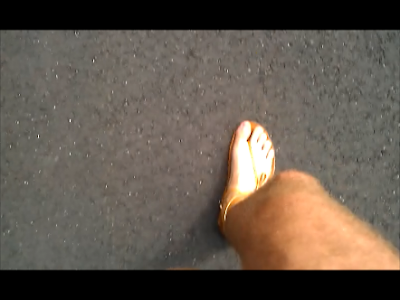My stride is shorter than usual with a faster turnover. I measured the cadence at between 176 and 180 steps per minute. I’m also landing on my forefoot. I can hear a double splat with each step from the sound of both my forefoot and heel striking the ground.
I wasn't making any conscious effort to change my stride. The change seems to be a natural consequence of the "tactile feedback" you receive while running without any cushioning under your feet. In other words, your body finds a way to run that doesn't hurt.
In this first image, I’m still swinging my leg forward. My foot is angled slightly downward with toes splayed reaching for the ground.
Next, just before contact with the ground my foot rotates slightly to the outside.
The first contact with the ground occurs on the outside of my forefoot with just a slight bend in the knee.
Finally, my foot rolls back to level upon contact with the ground, my ankle bends as my shin moves to a vertical position and my heel strikes the ground. My knee is also bent.
So theoretically, the impact forces from this massive specimen of humanity smashing into the ground 180 times per minute are being distributed throughout the entire foot and leg. Splayed toes strike first, the ankle absorbs some of the force as the foot rolls inward then bends to lower the heel, and finally when the full weight of my body is transferred to the foot, my knee is bent to act like a shock absorber.
So far the change feels good until I start to get fatigued. This is a new motion that I particularly feel in my Achilles and calf. Building up mileage slowly will be very important to avoid injury.











No comments:
Post a Comment